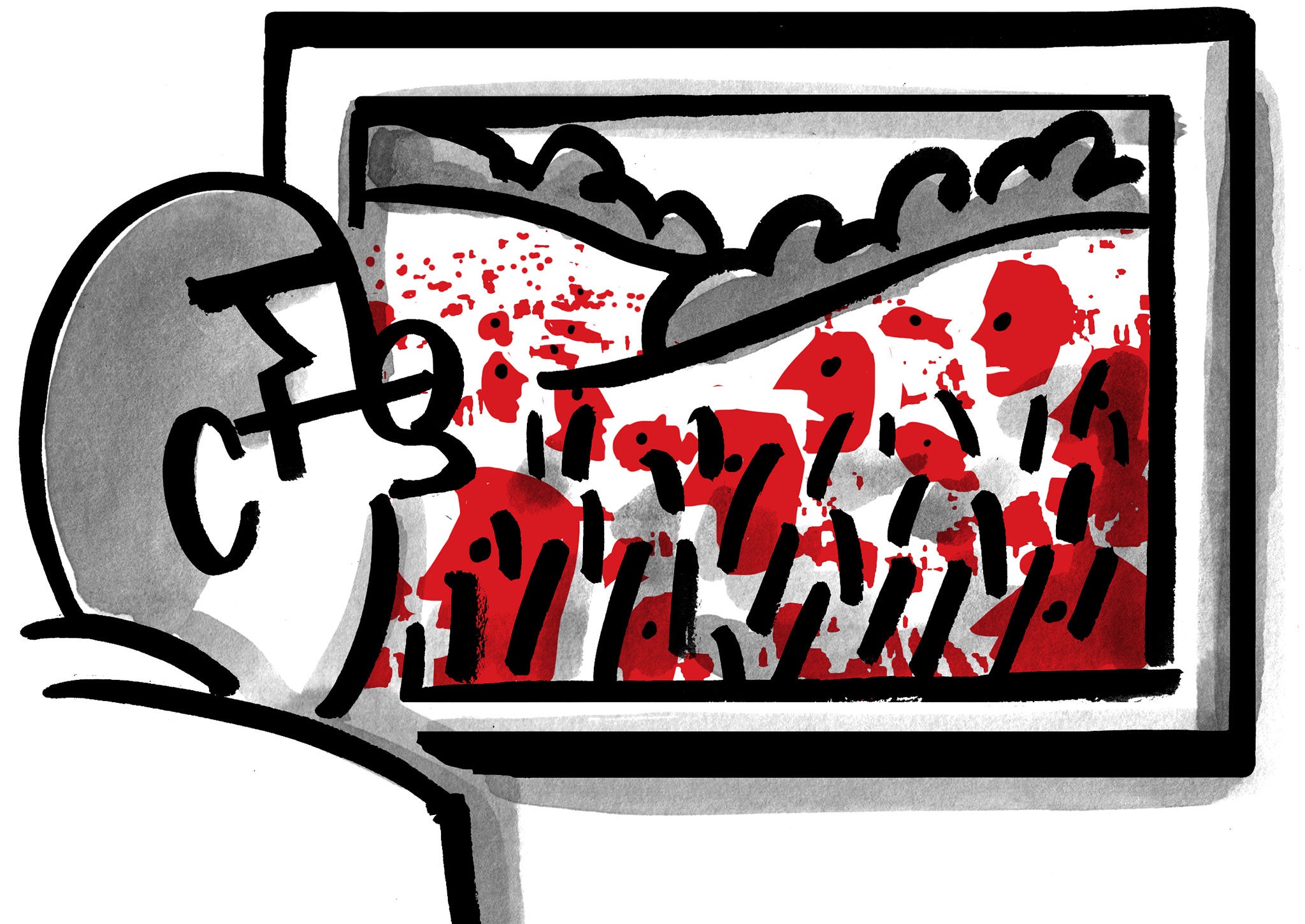Imagine... it’s 2014 and the drums of war are beating again
We don't know what World War Three might look like, but here's my calculated guess...


Newport had never seen anything like it.
On 4 September 2014, the luxury spa and golf resort of Celtic Manor in South Wales hosted the longest, loudest sigh of relief since the end of the Cuban missile crisis. A planned Nato summit meeting became the venue for a collective outpouring of gratitude for last-gasp deliverance.
The Third World War would not take place – or, at least, not yet. Bleary and haggard, diplomats, generals and backstage crisis managers high-fived, backslapped or simply sighed with bone-weary satisfaction. “Das war verdammt knapp!” cried the Germans around Chancellor Merkel. “Nous l’avons échappé belle!” the retinue of President Hollande agreed. “Close shave, guys,” the Obama camp echoed.
A few old hands from the Foreign Office and Ministry of Defence remembered the first Duke of Wellington, and “the nearest-run thing you ever saw in your life”. In Wales, however, the Nato allies convened to celebrate, with near-hysterical fervour, a Waterloo that never happened.
Even in the midst of a nail-biting sequence of events, many people had noted that the August crisis of 2014 brewed just as all its major players unrolled their programmes to commemorate the outbreak of the First World War, exactly 100 years before. It had proved far easier to organise centenary shindigs than to learn any serious lessons from the prelude to that bloodbath.
Sage after sage had explained that the July crisis of 1914 toppled into total war in spite of the lack of any appetite among the major actors for a prolonged conflict. For historian Christopher Clark, in his classic study The Sleepwalkers, the scheming powers of summer 1914 had “exploited the possibility of the general catastrophe as leverage in securing their own specific advantages”. All had hoped to gain. All would lose – on a cataclysmic scale. In August 2014, everyone knew that story. Yet they failed to act on the hard-won historical memory – until the last minute.
After the downing of flight MH17 by pro-Russian separatists in eastern Ukraine, the belated US and EU sanctions of late July had tried to slap a bill for proxy aggression on Vladimir Putin. But no one had dared to present it after the annexation of Crimea back in March. That inaction had emboldened his overt and covert backing for destabilisation in Ukraine.
To the Kremlin, this lurch from acquiescence to punishment cast the West in an unstable, capricious light. Who knew what those dithering hypocrites might do next? Putin’s closest advisers did know that Nato was about to rattle its sabres just over their fence. The unsubtly titled “Exercise Sabre Junction” had been arranged for late August. Due in October, “Exercise Black Eagle” in Poland would have a British battle group on board. The Russians detected a not so subtle plan to goad the bear.
Besides, they could see the West’s internal divisions. Within the EU, Paris and Berlin wanted the City of London to foot the bill for anti-Russian sanctions and leave their sweetheart deals on ships and gas intact. Meanwhile, Washington was distracted by the Gaza conflagration and the bloody march of the Islamic State. Luckily for the West, the Russians had thrown in their lot with secular tyrants such as Syria’s Assad. But the fear that Moscow might make an overture to anti-Israeli forces, most likely in Iran, gave Putin a high-value chip.
Under blazing skies, Dutch and Australian crash investigators picked over the grim debris of MH17. Then, on 6 August, the stakes rose again. Ukrainian army assaults on the rebel‑held cities of Donetsk and Luhansk resulted in scores of civilian deaths when schools and hospitals were hit. Who had fired the deadly rockets? In the dust storm of claim and counterclaim, Russia moved. Within a few days, tanks and troops surged across the border in a “humanitarian” mission to support the “Donetsk People’s Republic”. They rapidly pushed back Kiev’s overstretched units. A worldwide hearts-and-minds blitz portrayed the Donbas as a second Gaza, with the Kremlin its liberator. That link terrified Nato.
Although not a formal member of the alliance, Ukraine had since its 1997 partnership charter benefited from Nato guarantees. Could it now call on its “partners” for military support under Article 5 of the Washington Treaty, with its principle of “attack one and you attack us all”? Put on the spot, Western powers procrastinated. Behind all the brinkmanship and bluster, confusion reigned.
At least the deepening crisis had pushed Obama into brokering a robust ceasefire between Hamas and Israel. Day by day, Putin’s tanks continued to bite off bleeding chunks of eastern Ukraine. Then, on 14 August, came the Rezekne incident. Three ethnic Russian families were massacred in the provincial capital of Latgale in Latvia – another half-Russian region. Had Moscow special forces carried out the murders and blamed them on extreme Latvian nationalists?
Rival waves of propaganda swirled through cyberspace. The electronic fog of 21st-century “asymmetrical” warfare thickened. One fact lay beyond ambiguity: Latvian membership of Nato. If the Rezekne atrocity were exposed as a Russian provocation, then Latvia could plead Article 5. As it happens, a report of the House of Commons defence committee had, on 31 July 2014, pointed out the vulnerability of the Baltic states to the “information warfare” and “the inciting of disturbances that have caused such chaos in Ukraine”. It also sounded an alert about “the difficulty of invoking an Article 5 response following an asymmetric attack where it is difficult to prove a state actor is responsible”.
Putin, the master of deniable, “ambiguous” combat, understood all that. Then, as he had before but with apocalyptic risks this time, he overplayed his hand. On 23 August 2014, exactly 75 years after the Ribbentrop-Molotov pact, the Russian attacks on Latvia changed everything. As in Crimea, remotely orchestrated “uprisings” of Russian-speaking Latvians were suddenly guided by mysterious well-armed strangers. On 26 August, planes from the Russian base just across the border blitzed the Latvian air force headquarters at Lielvarde, knowing that its usual shield of Nato fighters had moved closer to Ukraine.
Putin cited as precedent the French, US and UK air attacks on Libyan forces around Benghazi in 2011 in order to forestall a massacre. In Latvia and Ukraine, Russia claimed that its operations served to defend civilian communities made up of its “own people”. As in 1914, so in 2014. “Non-state actors”, either genuine or fictitious, could disrupt the global balance of power.
Now the White House, with Europe tagging behind, had no choice but to react. All UN-sponsored mediation collapsed. With Article 5 in force, and de facto extended to Ukraine, the Nato forces already scheduled to move into the region on exercises were heavily reinforced.
Nato issued its 28 August ultimatum: a demand for an immediate end to all Russian military activity in and over Latvia, and a withdrawal of forces from Ukraine by midnight on 1 September. Without compliance, the Western assets mustered close by in Poland could exercise the right to act under Article 5. Few were comforted by the thought that both sides envisaged “only” non-nuclear strikes.
To a backdrop of the slaughtered children of Gaza and Donetsk, Putin indicted Western hypocrisy across the global media. Behind the scenes, however, the Russian elite squabbled and split. Blanket sanctions had cut deep into the ability of Moscow’s crony cash to move around the world. The oligarchs had begun to smart and bleed. So had the state-controlled banks and energy giants.
Meanwhile, Nato commanders were privately aghast. The most limited raids in Latvia or Ukraine would call forth an overwhelming counterstrike. Even without the nuclear option, that would leave both Ukraine and the Baltic states back in Moscow’s hands for good. Only in July, those British parliamentarians had warned that Nato “is currently not well prepared for a Russian threat against a member state”. Moscow knew the score and its hawks relished reversing at least some of the losses of 1989 and 1991.
It also had much popular opinion around the global “South” firmly on its side. But the very integration into Western capital and markets that had enriched the Putin clique also proved the fatal chink in its armour. By 1 September, the Kremlin had decided to claim a moral victory and back down. Its price? An autonomous Donetsk Republic that would, in short order, race down the Crimean route into complete integration with the Russian motherland. The ethnic Russians in the Baltic, having served their patriotic purpose, turned out to be rather more expendable – although Moscow mandated severe curbs on future Nato deployment in those states.
So, on 1 September, the planes stayed grounded and the tanks rolled back. Moscow had lost – and it had won. This was a reprieve, but not a resolution. “Ambiguous” war might still at any point flare into a red-hot menace to world peace. The August crisis of 2014 had not, as with the July crisis of 1914, led straight through the gates of hell – in part because no one now knew for sure where those gates stood or what precisely lay behind them.
Welcome to the long war in the shadows, Nato delegates darkly joked at Celtic Manor. Some of the relieved officials spotted that the resort normally offered guests an hour-long session of Laser Combat – “an exhilarating, pain-free, family combat game using hi-tech guns which fire infra-red beams”. Now, if only Moscow and Washington could settle for a best-of-five shoot-out with laser guns instead.
Join our commenting forum
Join thought-provoking conversations, follow other Independent readers and see their replies
Comments